- Home
- Offshore
- Services
- Capabilities
- Industries
- Big Data Analytics
- About Us
- Digital Marketing
- Resource
- Contact Us

The retail businesses of today, operate within a fiercely competitive experience economy where everycustomer interaction provides an opportunity to captivate and convert. UI/UX design is the frontrunner leading this dynamic environment. It serves as a subtle brand ambassador, invisibly steering customers through a smooth journey. It can be the determining factor between a short-lived visit and long-term loyalty. Before we delve deeper into this topic, let us understand the difference between UI and UX.
UI refers to the user interface—the actual surfaces and elements through which a user interacts with a product. For instance, think of the buttons and menus on your favorite shopping app. These are all part of the UI. UI is the tangible part of the product that users see and touch. It's about the look and functionality of the product's interface, focusing on visual design elements that make the interaction possible.
On the other hand, UX encompasses the entire user journey with a product. It's a holistic concept that includes the UI but also extends to every aspect of the user's interaction with the product, including the emotional and psychological aspects. UX is about solving the user's problems and ensuring that the product meets their needs effectively. It involves research, testing, and iteration to create a seamless and satisfying experience.
Now that we know the difference between UI and UX, let us again go through what the common fundamental that drives exceptional design.
Building a phenomenal retail experience is an important aspect of UI or UX. It is all about deep understanding of the user. It's about wearing their shoes, comprehending their desires, and crafting an experience that resonates with their deepest needs. It transcends aesthetics, making a connection that taps into the emotional and functional aspects where true engagement thrives.
This understanding is universal and goes beyond demographics. It delves into user psychology, motivations, and pain points. For example, a busy parent shopping for clothes for their child will have efficiency as their top priority while– finding the right size and style quickly. However, for a millennial browsing for a new gadget, the experience might be about discovery and inspiration – wanting to learn about different features and see the product in action. By understanding these diverse user personas, UI/UX design caters to individual needs and creates a truly personalized experience.

Despite knowing the above user-centric philosophy for creating a user experience, we have the retail landscape littered with products and stores that need to resonate with their intended audience. Why does this happen? Most of the time it is due to lack of alignment between the product or store and the people it serves.
Imagine a mobile app designed for seniors with tiny text and overly complex menus. Or a physical store with loud music and flashing lights that overwhelms customers seeking a calm shopping experience. These misalignments create frustration and ultimately drive customers away.
To avoid these missteps, we champion a human-centered design approach at SMARTnCODE This means shedding biases and preconceptions, focusing not on what we think is best but on what the user truly needs. It's a shift from designing for ourselves to designing with the end-user in mind, ensuring every decision revolves around them. Human-centered design is an iterative process built on empathy and deep know-how of the user journey. Here are the best industry practices that we follow at SMARTnCODE to build a human-centered design:

With a strong foundation in empathy research and persona development, our human-centered design utilizes five core pillars to translate user needs into exceptional experiences:

Along with ourfive core principles above, we add design thinking, a problem-solving approach that involves empathizing with the user, defining the problem, ideating solutions, prototyping, and testing. It serves as the blueprint guiding us through the maze of user needs and business objectives. By adopting design thinking, we craft retail experiences that are not just functional but delightful, not just satisfactory but memorable.

In the fiercely competitive retail landscape, with ever-evolving customer expectations, UI/UX design isn't just a good-to-have conceptit's a strategic necessity. By placing the user at the heart of the design process, SMARTnCODE create experiences that are usable, useful, and uniquely delightful.If you'd like to harness the transformative power of UI/UX design to build a retail experience that stands out in a crowded market, reach out to our talented team today.